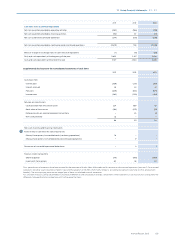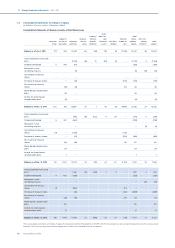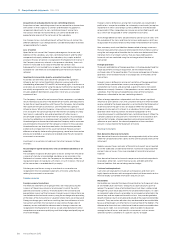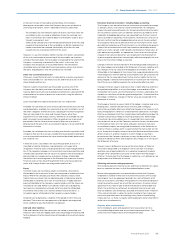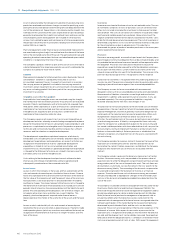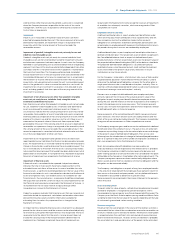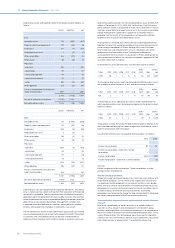Philips 2013 Annual Report Download - page 142
Download and view the complete annual report
Please find page 142 of the 2013 Philips annual report below. You can navigate through the pages in the report by either clicking on the pages listed below, or by using the keyword search tool below to find specific information within the annual report.
11 Group financial statements 11.9 - 11.9
142 Annual Report 2013
reliably, there is no continuing involvement with goods, and the amount of
revenue can be measured reliably. If it is probable that discounts will be
granted and the amount can be measured reliably, then the discount is
recognized as a reduction of revenue as the sales are recognized.
Transfer of risks and rewards varies depending on the individual terms of
the contract of sale. For consumer-type products in the sectors Lighting
and Consumer Lifestyle, these criteria are met at the time the product is
shipped and delivered to the customer and, depending on the delivery
conditions, title and risk have passed to the customer and acceptance of
the product, when contractually required, has been obtained, or, in cases
where such acceptance is not contractually required, when management
has established that all aforementioned conditions for revenue
recognition have been met. Examples of the above-mentioned delivery
conditions are ‘Free on Board point of delivery’ and ‘Costs, Insurance Paid
point of delivery’, where the point of delivery may be the shipping
warehouse or any other point of destination as agreed in the contract with
the customer and where title and risk for the goods pass to the customer.
Revenues of transactions that have separately identifiable components
are recognized based on their relative fair values. These transactions
mainly occur in the Healthcare sector and include arrangements that
require subsequent installation and training activities in order to become
operable for the customer. However, since payment for the equipment is
contingent upon the completion of the installation process, revenue
recognition is generally deferred until the installation has been completed
and the product is ready to be used by the customer in the way
contractually agreed.
Revenues are recorded net of sales taxes, customer discounts, rebates
and similar charges. For products for which a right of return exists during a
defined period, revenue recognition is determined based on the historical
pattern of actual returns, or in cases where such information is not
available, revenue recognition is postponed until the return period has
lapsed. Return policies are typically based on customary return
arrangements in local markets.
For products for which a residual value guarantee has been granted or a
buy-back arrangement has been concluded, revenue recognition takes
place when significant risks and rewards of ownership are transferred to
the customer. The following are the principal factors that the Company
considers in determining that the Company has transferred significant
risks and rewards:
• the period from the sale to the repurchase represents the major
(normally at least 75%) part of the economic life of the asset;
• the proceeds received on the initial transfer and the amount of any
residual value or repurchase price, measured on a present value basis,
is equal to substantially all (normally at least 90%) of the fair value of
the asset at the sale date;
• insurance risk is borne by the customer; however, if the customer bears
the insurance risk but the Company bears the remaining risks, then risks
and rewards have not been transferred to the customer; and
• the repurchase price is equal to the market value at the time of the buy-
back.
In case of loss under a sales agreement, the loss is recognized
immediately.
Shipping and handling billed to customers is recognized as revenues.
Expenses incurred for shipping and handling of internal movements of
goods are recorded as cost of sales. Shipping and handling related to sales
to third parties are recorded as selling expenses. When shipping and
handling is part of a project and billed to the customer, then the related
expenses are recorded as cost or sales. Service revenue related to repair
and maintenance activities for goods sold is recognized ratably over the
service period or as services are rendered.
A provision for product warranty is made at the time of revenue
recognition and reflects the estimated costs of replacement and free-of-
charge services that will be incurred by the Company with respect to the
products. For certain products, the customer has the option to purchase an
extension of the warranty, which is subsequently billed to the customer.
Revenue recognition occurs on a straight-line basis over the contract
period.
Revenue from services is recognized when the Company can reliably
measure the amount of revenue and the associated cost related to the
stage of completion of a contract or transaction, and the recovery of the
consideration is considered probable.
Royalty income, which is generally earned based upon a percentage of
sales or a fixed amount per product sold, is recognized on an accrual basis.
Grants from the government are recognized at their fair value where there
is a reasonable assurance that the grant will be received and the Company
will comply with all attached conditions. Government grants relating to
costs are deferred and recognized in the Statement of income over the
period necessary to match them with the costs that they are intended to
compensate.
Financial income and expenses
Financial income comprises interest income on funds invested (including
available-for-sale financial assets) and recognized surpluses for post-
employment benefit plans, dividend income, net gains on the disposal of
available-for-sale financial assets, net fair value gains on financial assets
at fair value through profit or loss, net gains on the remeasurement to fair
value of any pre-existing available-for-sale interest in an acquiree, and
net gains on hedging instruments that are recognized in the Statement of
income. Interest income is recognized on accrual basis in the Statement of
income, using the eective interest method. Dividend income is
recognized in the Statement of income on the date that the Company’s
right to receive payment is established, which in the case of quoted
securities is normally the ex-dividend date.
Financial expenses comprise interest expense on borrowings and
recognized deficits for post-employment benefit plans, unwinding of the
discount on provisions and contingent consideration, losses on disposal of
available-for-sale financial assets, net fair value losses on financial assets
at fair value through profit or loss, impairment losses recognized on
financial assets (other than trade receivables), net interest expenses
related to defined benefit plans and net losses on hedging instruments
that are recognized in the Statement of income.
Borrowing costs that are not directly attributable to the acquisition,
construction or production of a qualifying asset are recognized in the
Statement of income using the eective interest method.
Foreign currency gains and losses are reported on a net basis as either
financial income or financial cost depending on whether foreign currency
movements are in a net gain or net loss position.
Income tax
Income tax comprises current and deferred tax. Income tax is recognized
in the Statement of income except to the extent that it relates to items
recognized directly within equity or in other comprehensive income.
Current tax is the expected tax payable on the taxable income for the year,
using tax rates enacted or substantially-enacted at the reporting date, and
any adjustment to tax payable in respect of previous years.
Deferred tax assets and liabilities are recognized, using the balance sheet
method, for the expected tax consequences of temporary dierences
between the carrying amounts of assets and liabilities and the amounts
used for taxation purposes. Deferred tax is not recognized for the
following temporary dierences: the initial recognition of goodwill, the
initial recognition of assets and liabilities in a transaction that is not a
business combination and that aects neither accounting nor taxable
profit, and dierences relating to investments in subsidiaries to the extent
that they probably will not reverse in the foreseeable future. Deferred tax
is measured at the tax rates that are expected to be applied to temporary
dierences when they reverse, based on the laws that have been enacted
or substantially-enacted by the reporting date. Deferred tax assets and
liabilities are oset if there is a legally-enforceable right to oset current
tax liabilities and assets, and they relate to income taxes levied by the
same tax authority on the same taxable entity, or on dierent tax entities,
but they intend to settle current tax liabilities and assets on a net basis or
their tax assets and liabilities will be realized simultaneously.
A deferred tax asset is recognized for unused tax losses, tax credits and
deductible temporary dierences, to the extent that it is probable that
future taxable profits will be available against which they can be utilized.
The ultimate realization of deferred tax assets is dependent upon the
generation of future taxable income in the countries where the deferred
tax assets originated and during the periods when the deferred tax assets
become deductible. Management considers the scheduled reversal of
deferred tax liabilities, projected future taxable income, and tax planning
strategies in making this assessment.
Deferred tax liabilities for withholding taxes are recognized for
subsidiaries in situations where the income is to be paid out as dividend in
the foreseeable future, and for undistributed earnings of unconsolidated
companies to the extent that these withholding taxes are not expected to





